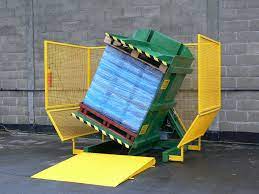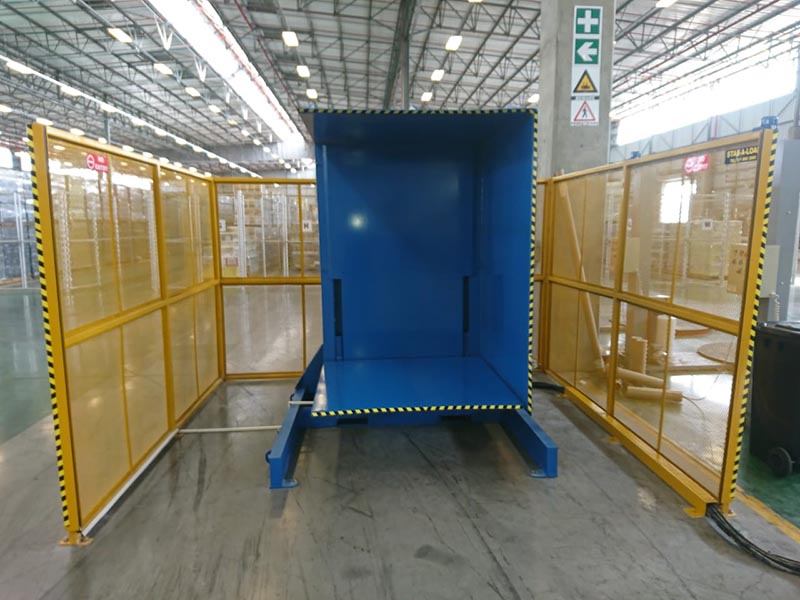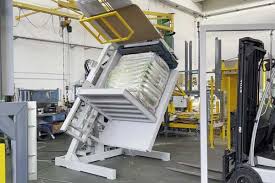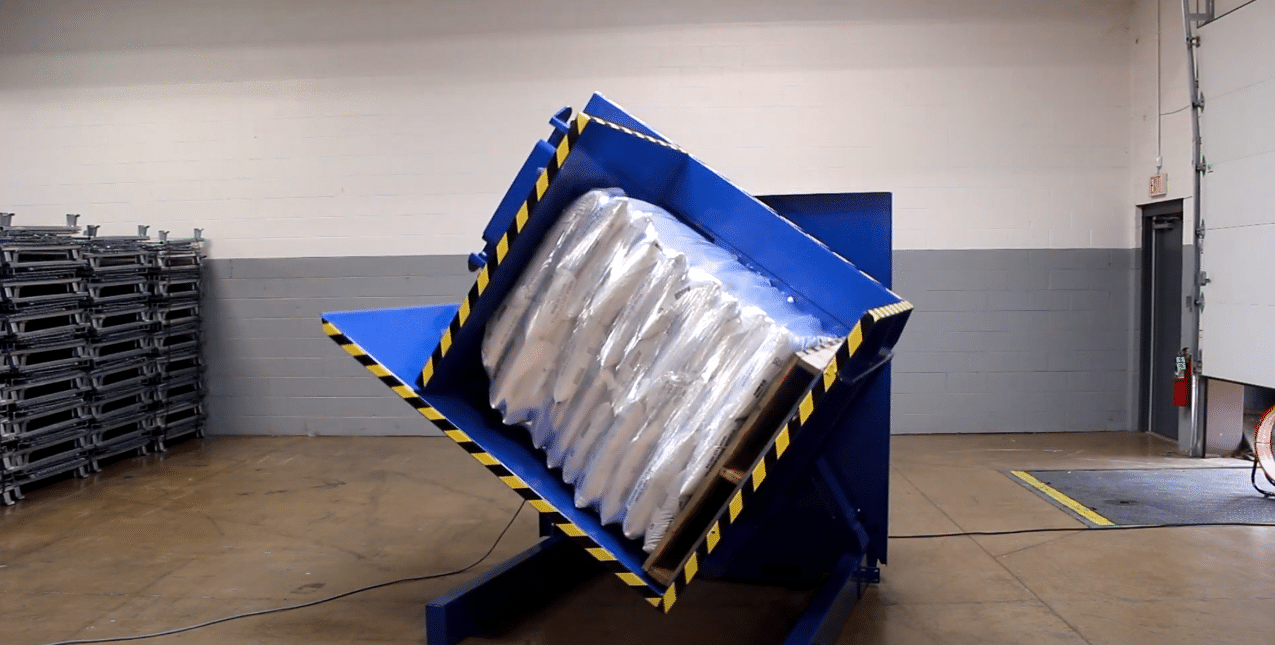How Pallet Inverters Solve Manual Handling in Food & Pharma Industries in Thailand?
Are you struggling with the slow, risky, and expensive process of manually transferring goods from one pallet to another? In Thailand's highly regulated food and pharmaceutical industries, every touchpoint is a potential risk for contamination, product damage, or worker injury. These small, daily inefficiencies add up, chipping away at your profit margins and exposing your business to the threat of costly recalls or compliance failures. There is, however, a proven engineering solution that directly tackles this problem, transforming your logistics from a liability into a streamlined asset.
Pallet inverters solve manual handling issues in Thailand's food and pharma sectors by automating the process of transferring goods between pallets. They securely clamp and rotate a full load, allowing an operator to quickly and safely switch from an external, potentially contaminated wooden pallet to a sanitized, in-house plastic or stainless steel pallet. This single action eliminates direct manual lifting, minimizes the risk of product contamination and damage, and drastically reduces the labor required, ensuring compliance with strict GMP and HACCP standards.

I've spent my entire career in the packaging machine industry, first as an engineer and now as the founder of SHJLPACK. I've seen firsthand how a single piece of smart equipment can revolutionize a company's operations. The challenges you face in Thailand are not unique, but the solutions must be precise. Let's explore exactly how this technology works and why it has become so essential for businesses that prioritize hygiene, safety, and efficiency.
Why is Manual Pallet Handling a Major Risk in Thailand's Food & Pharma Sectors?
Does your team still rely on restacking boxes by hand to change pallets? This common practice might seem like a simple task, but it hides significant risks that can impact your entire operation. You face constant pressure to prevent contamination, protect your workers from injury, and maintain efficiency, yet manual handling actively works against all these goals. The real cost isn't just the time it takes; it's the potential for a catastrophic failure, like a product recall or a serious workplace accident, that keeps managers awake at night. The solution begins with recognizing that this manual process is a fundamental weak point in your supply chain.
Manual handling is a major risk because it directly exposes products to human-borne contaminants, physical damage from being dropped or mishandled, and puts workers at high risk for musculoskeletal injuries. In Thailand's food and pharmaceutical industries, these risks directly violate the core principles of Good Manufacturing Practices (GMP) and Hazard Analysis and Critical Control Points (HACCP), which demand controlled, repeatable, and safe processes to ensure product integrity.

The Contamination Pathway
In the food and pharma sectors, hygiene is not just a goal; it's a license to operate. Wooden pallets arriving from outside your facility can carry moisture, mold, pests, and chemical residues. When your staff manually transfers goods from this "dirty" pallet to a clean, in-house one, they create multiple opportunities for cross-contamination. Every box they touch, every dropped item, and even the dust stirred up in the process can compromise an entire batch. From my experience helping a seafood processor in Bangkok, their biggest challenge was preventing contaminants from the receiving dock from entering the clean processing area. Manual restacking was their single biggest point of failure in audits. An automated system creates a physical barrier and a controlled procedure, breaking this contamination pathway.
The Ergonomic and Safety Crisis
Manual handling is a leading cause of workplace injuries, particularly back strains and repetitive stress injuries. Consider a standard pallet loaded with 1,000 kg of product in 20 kg boxes. That's 50 boxes that need to be lifted, moved, and placed. This repetitive bending and lifting, often performed under pressure to work quickly, is an ergonomic nightmare. In Thailand, where labor laws and worker safety are gaining importance, a single serious injury can lead to significant costs from compensation claims, lost workdays, and higher insurance premiums. A pallet inverter removes this physical strain entirely. The operator uses simple controls to let the machine do the heavy lifting, protecting your most valuable asset: your people.
The Hidden Costs of Inefficiency
How long does it take two or three of your workers to manually destack and restack a pallet? Ten minutes? Fifteen? Now, multiply that by the number of pallets you process each day. The labor cost alone is substantial. But there are other costs. Manual handling is inconsistent. Products can be dropped, boxes crushed, and packaging torn. This damage leads to write-offs that directly eat into your profit. Furthermore, this manual bottleneck slows down your entire internal logistics chain, from receiving to production staging. An inefficient process at one point creates delays everywhere else.
| Risk Factor | Manual Handling | Pallet Inverter Solution |
|---|---|---|
| Contamination | High risk of contact with dirty pallets, dust, human hands. | Creates a "no-touch" transfer to a sanitized pallet. |
| Product Damage | High probability of dropped boxes, crushed packaging. | Securely clamps and gently rotates the entire load as one unit. |
| Worker Injury | High risk of back strain, repetitive stress injuries. | Eliminates all manual lifting of heavy loads. |
| Speed | Slow. Requires 2-3 workers for 10-15 minutes per pallet. | Fast. Requires 1 operator for about 60 seconds per pallet. |
| Process Control | Inconsistent, depends on the worker. Difficult to audit. | Standardized, repeatable, and easily documented process. |
How Exactly Do Pallet Inverters Improve Hygiene and Compliance?
Are you constantly worried about passing your next GMP or HACCP audit? The paperwork and procedures are one thing, but inspectors are looking for tangible, physical controls that prevent contamination. When they see a team manually handling products between outside and inside pallets, they see a major compliance gap. How can you prove your process is truly hygienic when it relies on human intervention? The key is to introduce a system that is inherently clean and controllable, giving you a clear, defensible answer for any auditor.
Pallet inverters improve hygiene by creating a controlled, "no-touch" transfer process that is critical for compliance. They enable a clear segregation strategy, allowing you to move goods from unhygienic external pallets (like wood) to sanitized, GMP-compliant in-house pallets (like plastic or stainless steel) without manual contact with the product itself. This automated and enclosed method minimizes the introduction of contaminants and provides a documented, repeatable procedure that satisfies auditors from the Thai FDA and other regulatory bodies.

The Power of Pallet Segregation
The foundation of hygiene in a controlled environment is segregation. You must separate "outside" elements from "inside" processes. Pallets are a primary vehicle for bringing contaminants into your facility. Wood pallets, in particular, are porous and can harbor bacteria, insects, and moisture. Many food and pharma companies in Thailand enforce a strict policy: no outside wooden pallets beyond the receiving area. A pallet inverter is the perfect tool to enforce this rule. It acts as a gatekeeper. The forklift brings the wooden pallet to the inverter, the machine performs the exchange, and a different internal forklift takes the product away on a clean plastic pallet. This creates a clean break, a physical barrier that is easy to monitor and enforce.
Material Choices and Cleanability
The design of the machine itself is crucial for hygiene. For the food and pharmaceutical industries, standard painted steel is often not enough. That’s why we often recommend and build pallet inverters with stainless steel construction, especially for any surfaces that might be near the product. Stainless steel is non-porous, corrosion-resistant, and easy to clean and sanitize. Some models are even designed for full wash-down environments, with sealed bearings and waterproof electronics. When an auditor sees a stainless steel, wash-down-ready pallet inverter, they see a company that is serious about hygiene. It's a visible investment in compliance.
Documenting a Controlled Process for Audits
During an audit, you need to prove your processes are under control. A manual process is difficult to document and prove. How do you guarantee every worker follows the exact same procedure every time? You can't. An automated process, however, is perfectly repeatable. The pallet inverter performs the same gentle, secure rotation every single time. You can write a Standard Operating Procedure (SOP) around the machine's function. The process becomes:
- Load pallet into the inverter.
- Place clean pallet on top.
- Press button to initiate cycle.
- Remove product on clean pallet.
This is a simple, controlled, and easily documented process that demonstrates to auditors that you have removed human variability and risk from a critical control point. I remember working with a pharmaceutical client in the Navanakorn Industrial Zone. They failed an audit because of their manual pallet exchange. After installing a pallet inverter, they passed their next audit with flying colors, and the auditor specifically noted the machine as a key process improvement.
| Feature | Hygienic Benefit | Relevance to Thai Regulations (GMP/HACCP) |
|---|---|---|
| Stainless Steel Construction | Non-porous, easy to sanitize, resists corrosion. | Meets material requirements for food/pharma contact surfaces. |
| Enclosed Clamping System | Protects the load from airborne dust and contaminants during rotation. | Supports the principle of preventing environmental contamination. |
| Automated "No-Touch" Cycle | Eliminates direct human handling of the product units. | Reduces the risk of human-borne pathogens, a key HACCP control. |
| Wash-down Capability | Allows for thorough cleaning and sanitization of the equipment itself. | Ensures the equipment does not become a source of contamination. |
What are the ROI and Efficiency Gains from Using a Pallet Inverter?
As a business owner, every investment must answer one question: what is the return? You might see the safety and hygiene benefits of a pallet inverter, but you need to justify the cost on your balance sheet. You are facing rising labor costs, pressure on profit margins, and the constant need to do more with less. Spending money on new equipment can seem daunting. But what if that equipment paid for itself by drastically cutting your operational costs and eliminating waste? The return on investment (ROI) for a pallet inverter is not abstract; it's calculated in saved wages, prevented product loss, and increased throughput.
The ROI and efficiency gains from a pallet inverter are clear and measurable. They come primarily from a massive reduction in labor costs, the near-total elimination of product damage during pallet transfers, and a significant increase in operational speed. A task that once required several workers and many minutes to complete can now be done safely by a single operator in under 60 seconds, directly translating to higher productivity and a stronger bottom line.

Calculating the Labor Cost Savings
Let's do some simple math. Assume you need two workers to manually transfer a pallet, and it takes them 15 minutes. In Thailand, the daily wage for a skilled worker can be around 500 THB, or about 62.5 THB per hour.
- Manual Process: 2 workers x 0.25 hours/pallet x 62.5 THB/hour = 31.25 THB per pallet.
- Pallet Inverter Process: 1 operator x (1 minute or 0.017 hours)/pallet x 62.5 THB/hour = 1.06 THB per pallet.
If you transfer 50 pallets a day, your daily labor cost for this single task drops from 1,562.5 THB to just 53 THB. That's a savings of over 1,500 THB per day, which adds up to more than 450,000 THB in a year of 300 working days. This calculation doesn't even include the cost of supervision or the opportunity cost of having those workers perform more valuable tasks. The labor savings alone can often justify the investment in less than two years.
The Value of Undamaged Goods
Every time a box is dropped or crushed during manual handling, that's a direct loss. For high-value goods like pharmaceuticals or premium food products, this loss can be substantial. A single damaged case could be worth thousands of baht. A pallet inverter clamps the entire load securely before gently rotating it. The product never moves relative to the pallet, and the risk of dropping an item is virtually zero. By calculating your average monthly loss from product damaged during this specific process, you can identify another clear source of savings that contributes to the ROI. For one of our clients in the beverage industry, reducing damage by just 0.5% saved them enough to pay for the machine in 18 months.
Throughput: From Minutes to Seconds
Efficiency is not just about cost; it's about speed. A manual process that takes 15 minutes creates a bottleneck. Trucks may have to wait longer to be unloaded. Production lines may have to wait for raw materials. A pallet inverter that completes the same task in 60 seconds removes this bottleneck. It smooths out your entire logistics flow. This increased throughput means you can handle more volume with the same number of staff and in the same amount of space. This ability to scale your operations without adding more labor or warehouse space is a massive competitive advantage.
| Cost Category | Manual Process (Annual Cost) | Pallet Inverter (Annual Cost) | Annual Savings |
|---|---|---|---|
| Labor (50 pallets/day) | 468,750 THB | 15,900 THB | 452,850 THB |
| Product Damage (Est. 0.5%) | 250,000 THB | 5,000 THB | 245,000 THB |
| Worker Injury Claims (Est.) | 50,000 THB | 0 THB | 50,000 THB |
| Total Annual Savings | 747,850 THB |
My Insights: It's About the Total Solution, Not Just the Machine
I started my career on the factory floor as an engineer. I learned how machines work, but more importantly, I learned what happens when they don't work. I've seen the frustration of production managers dealing with equipment that isn't quite right for the job. When I founded SHJLPACK, I carried that experience with me. My goal was never just to sell a machine. It was to provide a complete solution. That’s our slogan: TOTAL SOLUTION FOR WRAPPING MACHINE. This means understanding your specific problem, whether it's in a food factory in Thailand or a steel mill in Mexico, and providing a tool that truly solves it.
When we talk about a pallet inverter, we are not just talking about a piece of steel that turns things over. We are talking about a strategic tool that impacts your business in multiple ways. It improves safety, ensures compliance, and boosts your bottom line. A good supplier understands this. They don't just send you a quote; they ask questions. They want to know about your product, your pallet types, your workflow, and your business goals. They act as a partner, not just a vendor.

Thinking Like an Owner
Having built my own factory, I understand the mindset of an owner like Javier Morales. Every investment is scrutinized. You need to see a clear path to return. You value stability, efficiency, and partners who can provide long-term support. The principles are the same everywhere. A steel mill owner worries about production uptime and cost per ton; a food factory owner worries about hygiene and cost per unit. Both are looking for robust, reliable equipment that lowers operational costs and reduces risk.
This is why a "total solution" approach is so critical. It involves:
- Consultation: Helping you select the right model and configuration (e.g., stainless steel vs. painted, loading method).
- Integration: Ensuring the machine fits seamlessly into your existing workflow and facility layout.
- Training: Making sure your operators can use the equipment safely and efficiently.
- After-Sales Support: Providing maintenance advice and spare parts to ensure maximum uptime for years to come.
I am grateful that my journey in this industry has allowed me to achieve my goals. Now, my mission with SHJLPACK is to share what I've learned to help others succeed. My advice is to look beyond the price tag of a machine. Look for a partner who understands your challenges and is committed to providing a solution that delivers real, measurable value. Whether you are handling bags of cement, rolls of steel, or boxes of medicine, the right equipment, backed by the right expertise, is what will help your business grow.
Conclusion
A pallet inverter is a vital investment for modern food and pharma operations in Thailand. It directly solves manual handling risks, ensuring hygiene, safety, and a fast return on investment.



